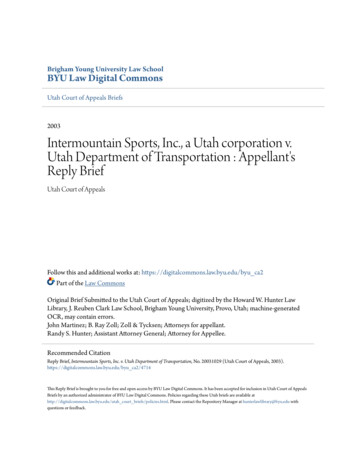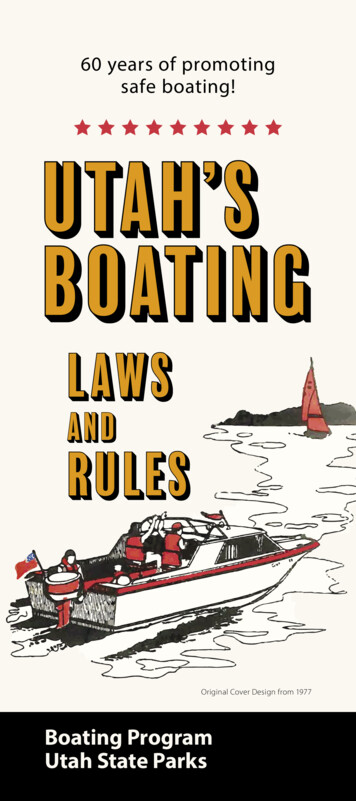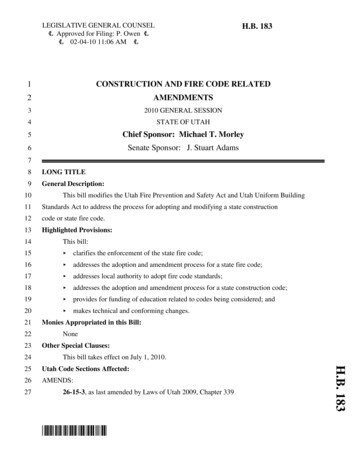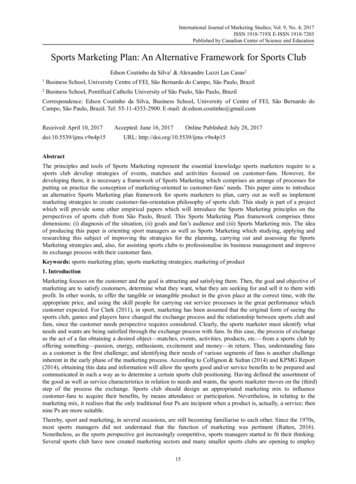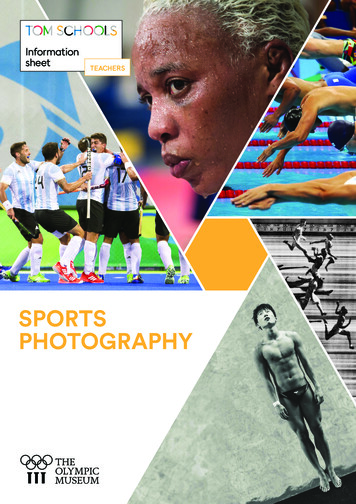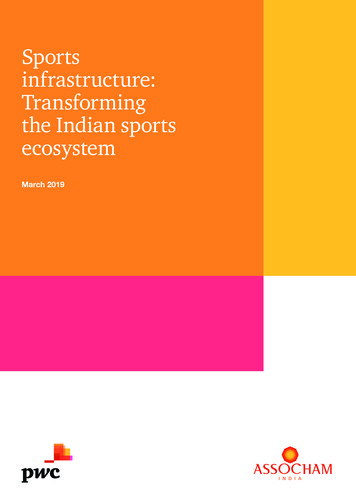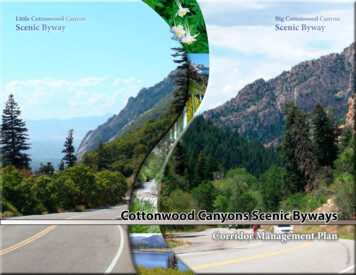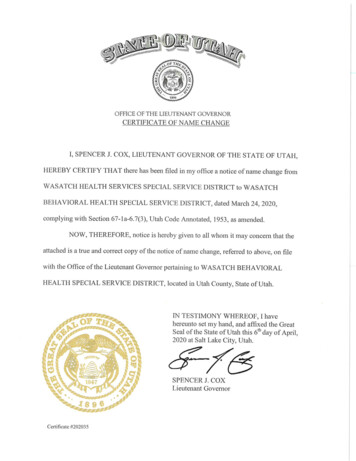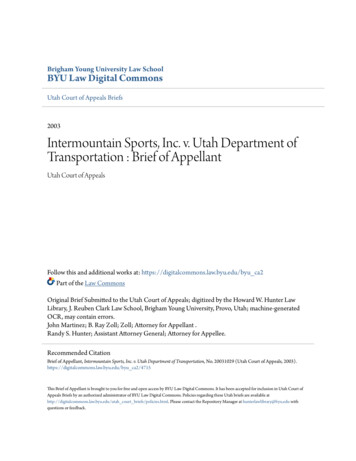
Transcription
Brigham Young University Law SchoolBYU Law Digital CommonsUtah Court of Appeals Briefs2003Intermountain Sports, Inc. v. Utah Department ofTransportation : Brief of AppellantUtah Court of AppealsFollow this and additional works at: https://digitalcommons.law.byu.edu/byu ca2Part of the Law CommonsOriginal Brief Submitted to the Utah Court of Appeals; digitized by the Howard W. Hunter LawLibrary, J. Reuben Clark Law School, Brigham Young University, Provo, Utah; machine-generatedOCR, may contain errors.John Martinez; B. Ray Zoll; Zoll; Attorney for Appellant .Randy S. Hunter; Assistant Attorney General; Attorney for Appellee.Recommended CitationBrief of Appellant, Intermountain Sports, Inc. v. Utah Department of Transportation, No. 20031029 (Utah Court of Appeals, 2003).https://digitalcommons.law.byu.edu/byu ca2/4715This Brief of Appellant is brought to you for free and open access by BYU Law Digital Commons. It has been accepted for inclusion in Utah Court ofAppeals Briefs by an authorized administrator of BYU Law Digital Commons. Policies regarding these Utah briefs are available athttp://digitalcommons.law.byu.edu/utah court briefs/policies.html. Please contact the Repository Manager at hunterlawlibrary@byu.edu withquestions or feedback.
IN THE UTAH COURT OF APPEALSINTERMOUNTAIN SPORTS, INC.,a Utah Corporation,Plaintiff-Appellant,Case No. 20031029-CAv.UTAH DEPARTMENT OFTRANSPORTATION,Defendant-Appellee.Court and judge below:Third Judicial District, Salt Lake CountyJudge William B. BohlingAPPELLANT'S OPENING BRIEFAPPEALAttorney for Appellee:RANDY S. HUNTERAssistant Attorney General160 East 300 South, 5th FloorSalt Lake City, Utah 84114-0857Attorneys for Appellant:JOHN MARTINEZ (USBA #4523)2974 East St. Mary's CircleSalt Lake City, Utah 84108B. RAY ZOLL (USBA#3607)ZOLL & TYCKSEN, L.C.5300 South 360 West, Suite 360Murray, Utah 84123FILEDUTAH APPELLATE COURTSMAYI220W(Oral Argument and Published Decision Requested)Digitized by the Howard W. Hunter Law Library, J. Reuben Clark Law School, BYU.Machine-generated OCR, may contain errors.
TABLE OF AUTHORITIESUTAH STATE CASESState v. FLxel, 945 P.2d 149,151 (Utah Ct. App. 1997)State v. Longshaw, 961 P.2d 925, 927 (Utah Ct. App. 1998)State v. Moosman, 794 P.2d 474, 480 (Utah 1990)State v. Stevenson, 884 P.2d 1287,1290 (Utah Ct. App. 1994)State v. Troy, 688 P.2d 483, 486 (Utah 1984)2213714State v. Valdez, 513 P.2d 422, 426 (1973)11,15State v. Webb, 779 P.2d 1108,1112 (Utah 1989)12,13STATUTES AND RULESUNITED STATES CONSTITUTIONAMENDMENT 62,6,12UTAH CODE ANNOTATED§76-4-4043§78-2a-3(2)(e)1UTAH RULES OF CRIMINAL PROCEDURERULE 404(b)3Digitized by the Howard W. Hunter Law Library, J. Reuben Clark Law School, BYU.Machine-generated OCR, may contain errors.
Pursuant to Utah Rule ofAppellate Procedure 24(a), Plaintiff-Appellant IntermountainSports, Inc., (hereinafter "Appellant"), by and through its counsel of record John Martinezand B. Ray Zoll, hereby submits the following Opening Brief:LIST OF PARTIESThe parties to this appeal are identified in the caption herein. Appellant's claims againstMurray City were dismissed by stipulation and are not the subject of this appeal. (R. 281)TABLE OF CONTENTSPAGELIST OF PARTIES. . . . iiTABLE OF CONTENTSiiTABLE OF AUTHORITIESivJURISDICTION1ISSUES AND STANDARDS OF REVIEW1CONSTITUTIONAL PROVISIONS, STATUTES AND RULESOF CENTRAL IMPORTANCE TO THIS APPEAL4STATEMENT OF THE CASE.;Nature of the case, course of proceedings, disposition in court belowStatement of Facts555SUMMARY OF ARGUMENT7ARGUMENT9I. INVERSE CONDEMNATION CLAIM:UDOT INVERSELY CONDEMNED APPELLANT'S RIGHT TO USEITS LAND FOR THE OPERATION OF A COMMERCIAL BUSINESS 9Introduction9A.The relevant property is Appellant's "right to use its land for theoperation of a commercial business," not physical "access to property"Digitized by the Howard W. Hunter Law Library, J. Reuben Clark Law School, BYU.Machine-generated OCR, may contain errors.
IL "Property" in the legal sense means legal rights1112. The right to use land is a distinct protected rightB.C.12Appellant properly alleged two types of "takings": "substantialinterference" with the operation of its commercial enterprise which"destroyed or materially lessened its value" in excess of 2 Million, and"substantial interference" with the operation of its commercialenterprise whereby Appellants right to "use and enjoyment" of itscommercial enterprise was substantially "abridged or destroyed" inexcess of 2 Million16jUDOTs reconstruction of 1-15 caused a taking for a "public use" ofAppellant's right to use its land for operation of a commercial enterprise19iD.Appellant's loss of business resulting from UDOTs closure of the 45thSouth offramp for about 4 years during the 1-15 reconstruction waslegally cognizable "harm" which, if a jury so determines, iscompensable20E.UDOTs closure of the 45th South offramp for about 4 years during the1-15 reconstruction "caused" Appellant's harm which, if a jury sodetermines, renders UDOT liable for the resulting harm22 F.The jury also may offset any special benefits Appellant derived fromthe project23II. UNIFORM OPERATION OF LAWS CLAIM:UDOT UNLAWFULLY DISCRIMINATED AGAINST APPELLANT 25A.The statutes from which UDOT draws its power to construct freewaysand authorize UDOT to dictate the manner in which such constructionwill be performed are "laws" which were applied non-uniformly byUDOT, violating Appellant's right to Uniform Operation of Laws 25B.Appellant's allegation that UDOT unlawfully discriminated againstAppellant by arbitrarily and capriciously providing other businessessimilarly situated to Appellant with accommodations not provided toAppellant sufficiently alleges membership in an identifiable class forpurposes of Appellant's Uniform Operation of Laws claim27Digitized by the Howard W. Hunter Law Library, J. Reuben Clark Law School, BYU.Machine-generated OCR, may contain errors.
CONCLUSION29ADDENDUM30TABLE OF AUTHORITIESUNITED STATES CONSTITUTIONU.S. CONST, amend. V11UTAH STATE CONSTITUTIONUTAH CONST, art. I, Sec. 224,9,16,UTAH CONST, art. I, Sec. 24UTAH CODE ANNOTATEDUtah Code Ann. §§ 17A-3-201 etseg.Utah Code Ann. §§ 17A-3-204(l)(c)Utah Code Ann. § 17A-3-216(l)Utah Code Ann. § 17A-3-217(5)Utah Code Ann. § 17A-3-229Utah Code Ann. §§ 17A-3-301 et seaUtah Code Ann. §§ 17A-3-304(l)(c)Utah Code Ann. § 17A-3-316(l)Utah Code Ann. § 17A-3-317(5)Utah Code Ann. § 17A-3-330Utah Code Ann. § 72-5-103(1)Utah Code Ann. §§ 72-6-101--119Utah Code Ann. § 78-2-2(3)(j)Utah Code Ann. § 78-2a-3(2)(j)Utah Code Ann. §§ 78-34-1--78-34-20Utah Code Ann. § 78-34-1(6)Utah Code Ann. § 78-34-3(6)4,25.". . . .,24242424242424242424204,27, 3011102020UTAH RULESRule 24(a), Utah Rules App. ProcCASESAllegheny Pittsburgh Coal Co. v. County Comm'n of Webster Cty.,488 U.S. 336 (1989)Armstrong v. United States, 364 U.S. 40 (1960)Arndtv. First Interstate Bank of Utah, N.A., 1999 UT91, 991 P.2d584Bagford v. Ephraim City, 904 P.2d 1095 (Utah 1995)Bailey Service & Supply Corp. v. State Road Commission, 533 P.2d 882 (Utah 1975)Digitized by the Howard W. Hunter Law Library, J. Reuben Clark Law School, BYU.Machine-generated OCR, may contain errors.ii2611271219
Canyon Country Store v. Bracey, 781 P.2d 414 (Utah 1989)22Carpet Barn v. State, 786 P.2d 770 (Utah Ct App 1990)13, 13, 15, 15City of Monterey v. Del Monte Dunes at Monterey, Ltd., 526 U.S. 687 (1999)21Colman v. Utah State Land Board, 795 P.2d 622 (Utah 1990)1, 2, 2, 3, 3,4, 4, 10, 11, 16, 17, 18, 18, 18,19,19,19, 20, 22Cook Associates, Inc. v. Warnick, 664 P.2d 1161 (Utah 1983)22Diamond B-YRanches v. Tooele County, 2004 UT App 13514, 21Fairclough v. Salt Lake County, 10 Utah 2d 417, 354 P.2d 105 (1960) . . . .10Farmers New World Life Insurance Co. v. Bountiful City,803 P.2d 1241 (Utah 1990)10, 12, 23Faux v. Mickelsen, 725 P.2d 1372 (Utah 1986)27Fishbaugh v. Utah Power & Light, 969 P.2d 403 (Utah 1998)27Gallivan v. Walker, 2002 UT 89, 54 P.3d 106926Hawaii Housing Auth. v. Midkiff, 467 U.S. 229 (1984)19Highland Boy GoldMin. Co. v. Strickley, 28 Utah 215, 78 P. 296 (1904). . 19Houghton v. Dept. of Health, 2002 UT 101, 57 P.3d 1067 . 1,2, 2, 3, 3, 4,4, 17, 20, 22Lee v. Gaufin, 867 P.2d 572 (Utah 1993)26Lund v. Salt Lake County, 58 Utah 546, 200 P. 510 (1921)12Malan v. Lewis, 693 P.2d 661 (1984))25,27,28,28, 29, 29McGrew v. Industrial Commission, 96 Utah 203, 85 P.2d 608 (1938)11Monetaire Mining Co. v. Columbus Rexall Consol. Mines Co., 53 Utah 413,174 P. 172 (1918)12Nash v. Clark, 27 Utah 158, 75 P. 371 (1904)19Nordlinger v. Hahn, 505 U.S. 1 (1992)26Palazzolo v. Rhode Island, 533 U.S. 606 (2001)21Parkside Salt Lake Corp. v. Insure-Rite, Inc., 2001 UT App 347, 37 P.3d 1202 . . 19, 22Penn Cent. Transp. Co. v. City of New York, 438 U.S. 104 (1978)21Pigs Gun Club, Inc. v. Sanpete County, 2002 UT 17, 42 P.3d 37923Provo City Corp. v. Knudsen, 558 P.2d 1332 (Utah 1977)12Rocky Mountain Thrift Stores, Inc. v. Salt Lake City Corp.,784 P.2d 459 (Utah 1989)18, 18, 18,18,18,18,18,19Sawyers v. FMA Leasing Co., 722 P.2d 773 (Utah 1986)22Springville Banking Co. v. Burton, 10 Utah 2d 100, 349 P.2d 157 (1960) . . . .18State v. Schofield, 2002 UT 132, 63 P.3d 66725State Road Com'n v. Rozzelle, 101 Utah 464,120 P.2d 276 (1941)22Stockdale v. Rio Grande Western Ry. Co., 28 Utah 201, 77 P. 849 (1904)11The View Condominium Owners Ass'n v. MSICO, L.L.C., 2004 UT App 104,497 Utah Adv. Rep. 314, 20Three D Corporation v. Salt Lake City, 752 P.2d 1321(Utah Ct App 1988)13, 14, 15, 18U.S. v. District Court, 121 Utah 18, 242 P.2d 774 (1952)12Webber v. Salt Lake City, 40 Utah 221,120 P. 503 (1911)10Digitized by the Howard W. Hunter Law Library, J. Reuben Clark Law School, BYU.Machine-generated OCR, may contain errors.
ADDITIONAL AUTHORITIESProceedings and Debates of the Constitutional Convention (1898)9,9,12,12,21,23,23,30Martinez & Libonati, STATE AND LOCAL GOVERNMENT LAW,A Transactional Approach 312-39 (2000)103 Sands, Libonati & Martinez, LOCAL GOVERNMENT LAW,§§ 16.53.10-16.53.50104 Sands, Libonati & Martinez, LOCAL GOVERNMENT LAW,§§ 24.23--24.2424Digitized by the Howard W. Hunter Law Library, J. Reuben Clark Law School, BYU.Machine-generated OCR, may contain errors.
JURISDICTIONThis case was transferred to the Court of Appeals from the Utah Supreme Courtpursuant to Utah Code Ann. § 78-2a-3(2)(j)(2002); the Supreme Court had jurisdiction overthis case pursuant to Utah Code Ann. §78-2-2(3)(j)(2002), as an appeal from final judgment.ISSUES AND STANDARDS OF REVIEWA. Inverse Condemnation Claim1. "Relevant Property" Issue: Did the trial court erroneously conclude that the relevantproperty for purposes of Appellants inverse condemnation claim is "access to property,"rather than Appellant's "right as to use its land for the operation of a commercial business?"(R. 147-48; 11/10/03 HearingTr. p.23,11. 9-12, 17-20)Standard of Review: A grant of a motion for judgment on the pleadings for failureto state a claim is reviewed as a question of law for correctness. No deference is given to thetrial court. Factual allegations in the complaint and all reasonable inferences therefrom areaccepted as true and are considered in a light most favorable to the Appellant. Affirmanceis proper only if Appellant cannot prove any set of facts in support of its claims. Houghtonv. Dept. of Health. 2002 UT 101, f2, 57 P.3d 1067; Colman v. Utah State Land Board. 795P.2d 622, 624 (Utah 1990).2. "Taking" Issue: Did the trial court erroneously conclude that Appellant did not statea "takings" claim, even though Appellant alleged two "takings" claims: (1) a "substantialinterference" with the operation of its commercial enterprise which "destroyed or materiallylessened its value" in excess of 2 Million; and (2) a "substantial interference" with theDigitized by the Howard W. Hunter Law Library, J. Reuben Clark Law School, BYU.Machine-generated OCR, may contain errors.
operation of its commercial enterprise, whereby Appellant's right to the "use and enjoyment"of i ts c ommercial enterprise w as s ubstantially " abridged o r d estroyed" i n e xcess o f 2Million? (R. 148-50; 11/10/03 HearingTr. p.23,11. 12-14)Standard of Review: Question of law reviewed for correctness. No deference to trialcourt. Factual allegations and all reasonable inferences accepted as true and considered inlight most favorable to Appellant. Affirmance proper only if Appellant cannot prove any setof facts in support of its claims. Houghton v. Dept. of Health, 2002 UT 101, f2, 57 P.3d1067: Colman v. Utah State Land Board. 795 P.2d 622, 624 (Utah 1990).3. "Public Use" Issue: Although the trial court did not reach the issue, should thiscourt hold for purposes of remand that UDOTs reconstruction of 1-15, causing the taking ofAppellants right to use its land for operation of a commercial enterprise, was for a "publicuse?" (R. 150; 11/10/03 HearingTr. p. 23,11. 21-25, p.24,1.1)Standard of Review: Question of law reviewed for correctness. No deference to trialcourt. Factual allegations and all reasonable inferences accepted as true and considered inlight most favorable to Appellant. Affirmance proper only if Appellant cannot prove any setof facts in support of its claims. Houghton v. Dept. of Health, 2002 UT 101, f2, 57 P.3d1067; Colman v. Utah State Land Board, 795 P.2d 622, 624 (Utah 1990).4. "Harm" Issue: Did the trial court erroneously conclude that Appellant's loss ofbusiness resulting from UDOT's closure of the 45th South offramp for about 4 years duringthe 1-15 reconstruction—which the court characterized as a "temporary denial of access toproperty" which was not "permanent, continuous, or inevitably recurring"—was notDigitized by the Howard W. Hunter Law Library, J. Reuben Clark Law School, BYU.Machine-generated OCR, may contain errors.
icompensable harm as a matter of law? (R. 150-51; 11/10/03 HearingTr. p.20,11.20-23, p.24, Standard of Review: Question of law reviewed for correctness. No deference to trialcourt. Factual allegations and all reasonable inferences accepted as true and considered inlight most favorable to Appellant. Affirmance proper only if Appellant cannot prove any setof facts in support of its claims. Houghton v. Dept. of Health, 2002 UT 101, .f2, 57 P.3d41067; Colman v. Utah State Land Board, 795 P.2d 622, 624 (Utah 1990).5. "Causation" Issue: Did the trial court erroneously conclude that UDOTs closure of1the 45th South offramp for about 4 years during the 1-15 reconstruction did not "cause"Appellant's harm as a matter of law? (R. 151; 11/10/03 HearingTr. p.24,11. 4-12)Standard of Review: Question of law reviewed for correctness. No deference to trialcourt. Factual allegations and all reasonable inferences accepted as true and considered inlight most favorable to Appellant. Affirmance proper only if Appellant cannot prove any set*of facts in support of its claims. Houghton v. Dept. of Health, 2002 UT 101, f2, 57 P.3d1067; Colman v. Utah State Land Board. 795 P.2d 622, 624 (Utah 1990).iB. Uniform Operation of Laws Claim1. Identity of "Law" Issue: Did the trial court erroneously conclude that the statutesfrom which UDOT draws its power to construct freeways and authorize UDOT to dictate themanner in which such construction will be performed are not "laws" applied non-uniformlybyUDOT? (R. 152; 11/10/03 HearingTr. p.25,11.3-7)Digitized by the Howard W. Hunter Law Library, J. Reuben Clark Law School, BYU.Machine-generated OCR, may contain errors.4
Standard of Review: Question of law reviewed for correctness. No deference to trialcourt. Factual allegations and all reasonable inferences accepted as true and considered inlight most favorable to Appellant. Affirmance proper only if Appellant cannot prove any setof facts in support of its claims. Houghton v. Dept. of Health. 2002 UT 101, ]29 57 P.3d1067: Colman v. Utah State Land Board 795 P.2d 622, 624 (Utah 1990).2. Identity of "class" Issue: Did the trial court erroneously conclude that Appellant'sallegation that UDOT unlawfully discriminated against Appellant by arbitrarily andcapriciously providing other businesses similarly situated to Appellant with accommodationsnot provided to Appellant did not allege membership in an identifiable class? (R. 152;11/10/03 HearingTr. p.24,11.24-25; p.25,11.1-2)Standard of Review: Question of law reviewed for correctness. No deference to trialcourt. Factual allegations and all reasonable inferences accepted as true and considered inlight most favorable to Appellant. Affirmance proper only if Appellant cannot prove any setof facts in support of its claims. Houghton v. Dept. of Health, 2002 UT 101,1f2, 57 P.3d1067; Colman v. Utah State Land Board. 795 P.2d 622, 624 (Utah 1990).CONSTITUTIONAL PROVISIONS, STATUTES AND RULESOF CENTRAL IMPORTANCE TO THIS APPEALUTAH CONST, ART. I, §22.Private Property shall not be taken or damaged for public use without justcompensation.UTAH CONST, ART. I, §24.All laws of a general nature shall have uniform operation.UTAH CODE ANN.§§ 72-6-101-119, inclusive. (Addendum Exhibit 1)Digitized by the Howard W. Hunter Law Library, J. Reuben Clark Law School, BYU.Machine-generated OCR, may contain errors.
4STATEMENT OF THE CASE Nature of the case, course of proceedings, disposition in court below For over 15 years Appellant worked hard to develop his Recreational Vehicle (RV)sales business in order to provide for his family and enjoy the fruits of his labors. Then overa period of 4 years, from 1997 through 2001, UDOT rebuilt the 1-15 freeway and effectivelyran Appellant out of business. UDOTfs position is that the project "require[d] the breakingjof eggs," and that Appellant's loss of his livelihood is just too bad. (11/10/03 HearingTr. p.8,11.19-20)This case is about whether a jury should be given the opportunity to decide whetherfairness and justice demand that the approximately 2 Million in losses suffered by Appellantas a result of the 1-15 reconstruction should be borne by the people of the State as a whole,'rather than being left as a burden on Appellant alone. The trial court granted UDOT's motionfor judgment on the pleadings and entered final judgment dismissing Appellant's claims asga matter of law. (R. 286, Addendum Exhibit 2, p.2)Statement of Factsa. For over 15 years Appellant owned and operated an RV sales company on a parcelof land located at 4225 South 500 West in Murray, Utah, near the 4500 South offramp fromthe 1-15 freeway. (R. 2-3, Addendum Exhibit 3,1J8; 11/10/03 HearingTr. p.27,11. 4-20)*b. For about 4 years, from July 1997 to May 2001, UDOT conducted a massivereconstruction of the 1-15 freeway in order to benefit the people of Utah. (R. 5, AddendumExhibit 3,1fl[l9-22)Digitized by the Howard W. Hunter Law Library, J. Reuben Clark Law School, BYU.Machine-generated OCR, may contain errors.J
c. In July 1997, UDOT closed the 4500 South offramp adjacent to Appellant's RVbusiness as part of the 1-15 reconstruction project. (R. 5, Addendum Exhibit 3, f 19)d. From July 1997 through December 1998—a period of VA years-access toAppellant's RV business was closed. (R. 5, Addendum Exhibit 3, ff 19-20)e. From January 1999 through May 2001-an additional period of about 2lA yearsUDOT placed periodic closures on traffic at the 4500 South Street offramp. (R. 5, AddendumExhibit 3,121)f. Thus, from July 1997 until May 2001-a total period of nearly 4 years-UDOTeffectively closed the 4500 South offramp, as well as the streets for East and West trafficadjacent to the 4500 South offramp. (R. 5, Addendum Exhibit 3, [22)g. Instead of direct access off the 4500 South offramp, Appellant was left with acircuitous, 2.5-mile loop that snaked behind and around the area, thereby confusing,frustrating, and ultimately eliminating Appellant's potential customers. (R. 5-6, AddendumExhibit 3, 23)h. The net impact on Appellant from UDOT's I-15 reconstruction was that trafficflowon I-15 in the area of 4500 South Street dropped two-thirds from the traffic flow prior to suchreconstruction, and the bulk of the remaining 1/3 of Appellant's potential customers endedup getting lost and never arriving at Appellant's RV business. (R. 6, Addendum Exhibit 3,1f24)i. As a direct result of UDOTs reconstruction of 1-15, Appellant suffered losses inexcess of 2 Million. (R. 6, 9, Addendum Exhibit 3, ff25, 36, 37)Digitized by the Howard W. Hunter Law Library, J. Reuben Clark Law School, BYU.Machine-generated OCR, may contain errors.
j . UDOT provided other similarly situated businesses in the area with accommodationsifor direct access to 4500 South offramp traffic, and did not provide such accommodationsto Appellant, thereby unlawfully discriminating against Appellant. (R. 6, 10, AddendumExhibit 3 , 2 6 , 3 9 , 40)*SUMMARY OF ARGUMENTFor over 15 years Appellant worked hard to develop his Recreational Vehicle (RV) business in order to provide for his family and enjoy the fruits of his labors. Then over aperiod of 4 years, from 1997 through 2001, UDOT rebuilt the 1-15 freeway and effectivelyiran Appellant out of business. UDOTs position is that the project tfrequire[d] the breakingof eggs," and that Appellants loss of his livelihood is just too bad. (11/10/03 HearingTr. p.8,11.19-20)-j*This case is about whether a jury should be given the opportunity to decide whetherfairness andjustice demand that the approximately 2 Million in losses suffered by Appellant,as a result of the 1-15 reconstruction should be borne by the people of the State as a whole,rather than being left as a burden on Appellant alone. Appellant is not seeking a windfall orto raid the public treasury. As is well established in the analogous area of city and countyimprovement districts, the jury may offset any special benefits conferred on Appellant fromthe special harm suffered by Appellant as a result of the 1-15 reconstruction. Appellant asserts two constitutional claims against UDOT: Inverse Condemnation andUniform Operation of Laws. On its Inverse Condemnation claim, Appellant makes 6contentions: (1) The relevant property is Appellant's "right to use its land for the operationDigitized by the Howard W. Hunter Law Library, J. Reuben Clark Law School, BYU.Machine-generated OCR, may contain errors.
of a commercial business/1 not physical "access to property" as the trial court held. (2)Appellant properly stated two types of "takings," by alleging a "substantial interference" withthe operation of its commercial enterprise which "destroyed or materially lessened its value"in excess of 2 Million, and by alleging a "substantial interference" with the operation of itscommercial enterprise whereby Appellant's right to "use and enjoyment" of its commercialenterprise was substantially "abridged or destroyed" in excess of 2 Million. (3) UDOT'sreconstruction of 1-15 caused a taking for a "public use" of Appellant's right to use its landfor operation of a commercial enterprise. (4) Appellant's loss of business resulting fromUDOT's closure of the 45th South offramp for about 4 years during the 1-15 reconstructionwas legally cognizable "harm" which, if a jury so determines, is compensable. (5) UDOT'sclosure of the 45th South offramp for about 4 years during the 1-15 reconstruction "caused"Appellant's harm which, if a jury so determines, renders UDOT liable for the resulting harm.(6) A jury may offset any special benefits Appellant derived from the reconstruction project.On its Uniform Operation of Laws claim, Appellant makes 2 contentions: (1) Thestatutes from which UDOT draws its power to construct freeways and authorize UDOT todictate the manner in which such construction will be performed are "laws" which wereapplied non-uniformly by UDOT, violating Appellant's right to Uniform Operation of Laws.(2) Appellant's allegation that UDOT unlawfully discriminated against Appellant byarbitrarily and capriciously providing other businesses similarly situated to Appellant withaccommodations not provided to Appellant sufficiently alleges membership in an identifiableclass for purposes of Appellant's Uniform Operation of Laws claim.Digitized by the Howard W. Hunter Law Library, J. Reuben Clark Law School, BYU.Machine-generated OCR, may contain errors.
IARGUMENTII. INVERSE CONDEMNATION CLAIM:UDOT INVERSELY CONDEMNED APPELLANTS RIGHT TO USEITS LAND FOR THE OPERATION OF A COMMERCIAL BUSINESSIntroductionThe Just Compensation Clause of the Utah Constitution provides: "Private propertyshall not be taken or damaged for public use without just compensation." UTAH CONST, art. I,Sec. 22. Samuel R. Thurman, who introduced the Clause at the 1895 ConstitutionalConvention, set out most eloquently its importance in protecting private property from%governmental harm:"I believe that the right of property is a sacred right, and no matter if it is the widow'smite, I believe that the man who owns just one little ewe lamb has just as much rightto that as the man has to his cattle that graze on a thousand hills."[G]entlemen, this is a serious question we are dealing with. There is nothing moresacred than the right of property, unless it be the right to live and enjoy your liberty."Proceedingsand Debatesofthe ConstitutionalConvention, 336-37, 625-26(1898VAddendum Exhibit 4): see also id., 333 ("I don't believe there is a question to come4up before this Convention that will be of greater importance to it than the one that is beingdiscussed right now.H)(William F. James).The Just Compensation Clause protects against two general types of "condemnations:"(1) "Direct condemnation," as when a private home that lies in the path of a proposedfreeway is purchased "directly" by UDOT. There is no question that (A) "private property" (the home), (B) a "taking" (expropriation of the home), and (C) a "public use" (freeway), areDigitized by the Howard W. Hunter Law Library, J. Reuben Clark Law School, BYU.Machine-generated OCR, may contain errors.4
all present. In that setting, UDOT clearly is required to initiate a direct condemnationproceeding and pay fair market value to the owner. UTAH CODE ANN. § § 78-34-1 -78-34-20.(2) "Inverse condemnation," in contrast, occurs when private property is taken ordamaged for public use without initiation of direct condemnation proceedings by thegovernmental entity doing the "taking or damaging." Thus, if UDOT were to build a freewaymistakenly believing it already had title to land which was actually owned by a private party,the owner could bring an inverse condemnation action to require UDOT to pay justcompensation. Such an owner would be required to allege and prove: (A) a property interest,(B) had been taken or damaged (C) for public use. Farmers New World Life Insurance Co.v. Bountiful City. 803 P.2d 1241, 1243-44 (Utah 1990); for discussion of takings analysis,see 3 Sands, Libonati & Martinez, LOCAL GOVERNMENT LAW, §§ 16.53.10-16.53.50;Martinez & Libonati, STATE AND LOCAL GOVERNMENT LAW, A Transactional Approach 31239 (2000).Inverse condemnation law in Utah has followed a tortuous path. The Utah SupremeCourt initially held a claim could be brought directly under the Just Compensation Clausewithout implementing legislation. Webber v. Salt Lake City. 40 Utah 221,224,120 P. 503,504 (1911). The court later reversed itself, holding no such claim could be brought.Fairclough v. Salt Lake County. 10 Utah 2d 417, 354 P.2d 105 (1960). Then in 1990, theCourt reversed itself again, holding such a claim can be brought. Colman v. Utah State LandBoard, 795 P.2d 622, 630-34 (Utah 1990). Accordingly, constant resort to first principles isindispensable to keeping one's bearings in the field.Digitized by the Howard W. Hunter Law Library, J. Reuben Clark Law School, BYU.Machine-generated OCR, may contain errors.
The foundational principle of inverse condemnation law is that "The tendency underIour system is too often to sacrifice the individual to the community." Stockdale v. RioGrande Western Rv. Co. 28 Utah 201, 203, 77 P. 849, 852 (1904). Like the analogousfederal provision in the Fifth Amendment, the Utah Just Compensation Clause "was designedto bar Government from forcing some people alone to bear public burdens which, in allfairness and justice, should be borne by the public as a whole." U.S. CONST. AMEND. V; Armstrong v. United States. 364 U.S. 40,49 (I960).Appellant has the right under the Utah Constitution to have a jury decide whetherifairness and justice require that the costs Appellant suffered as a direct result of the 1-15reconstruction should be borne by the public, and not shouldered by Appellant alone.A.The relevant property is Appellant's "right to use its land for the operation ofa commercial business," not physical "access to property"The trial court characterized Appellant's property as "convenient access to thefreeway". (R. 291, Addendum Exhibit 2, p.7, f 17.) The trial court thereby misconceived therelevant property as physical access, rather than the legal right to use land.1. "Property" in the legal sense means legal rights4"The word "property" although in common parlance applied to a tract of land or achattel, to a physical thing, means in its legal signification only therightsof the ownerin relation to it. Property is the right of any person to possess, use, enjoy and disposeof a thing. The term "property" is often used to indicate the res, or subject of theproperty rather than the property itself. "McGrew v. Industrial Commission. 96 Utah 203, 204, 85 P.2d 608, 610 (1938). See alsoIColman 795 P.2d at 625 ("some protectible interest").Digitized by the Howard W. Hunter Law Library, J. Reuben Clark Law School, BYU.Machine-generated OCR, may contain errors.
The types of rights protected under Article I Section 22 are "practically unlimited.ffFarmers New World Life Insurance Co. v. Bountiful City, 803 P.2d at 1244, quoting Lundv. Salt Lake County. 58 Utah 546, 200 P. 510, 512 (1921). Inverse condemnation protects"every species of property . . . including legal and equitable rights of every description."Bagfordv.EphraimCitv. 904P.2d 1095,1098 (Utah 1995).2. The
B. RAY ZOLL (USBA#3607) ZOLL & TYCKSEN, L.C. 5300 South 360 West, Suite 360 Murray, Utah 84123 FILED UTAH APPELLATE COURTS MAYI220W . Farmers New World Life Insurance Co. v. Bountiful City, 803 P.2d 1241 (Utah 1990) 10, 12, 23 Faux v. Mickelsen, 725 P.2d 1372 (Utah 1986) 27

